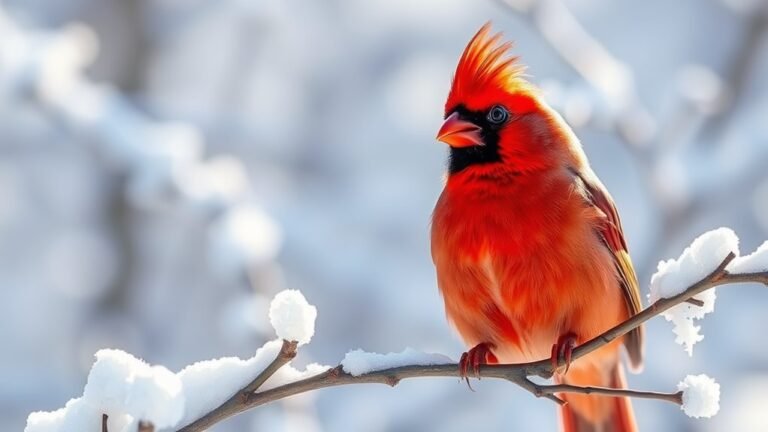Why Do Birds Fly South for Winter? Migration Mysteries Unveiled
Many birds leave in winter to fly south. They do this to find better conditions. This migration occurs because of weather changes and the availability of food. Each bird species has its own reasons for migrating, but the main factors include survival and environmental signals. Understanding what motivates these birds and how they face challenges during their journeys is both interesting and important.
Key Takeaways
Birds fly south in winter to find warmer weather. They do this to escape cold temperatures that can harm them. In northern regions, food becomes scarce in winter, so birds migrate to areas with more food available. The timing of migration depends on seasonal changes in temperature and food supply.
Birds use instinct and learned behaviors to help them find their way. They use environmental cues like the sun and stars for navigation. Climate change affects migration patterns, which can change when birds migrate and alter their access to food.
This journey is crucial for their survival. By understanding why birds migrate, we can appreciate their resilience and adaptabilities.
The Basics of Bird Migration
Bird migration is a captivating event that interests scientists and birdwatchers. Each year, birds travel from their breeding grounds, where they nest and raise their young, to warmer areas to survive the winter. These journeys can cover thousands of miles.
Birds use their natural instincts and environmental signs to guide them. Their migratory routes depend on geography, food availability, and the presence of predators.
As you observe birds flying in groups, remember that each bird contributes to this system. This journey creates a sense of connection among species.
Learning the basics of bird migration can deepen your appreciation for the determination of migratory birds and their incredible journeys.
The Role of Weather and Seasons
Bird migration greatly depends on the weather and seasons. When you watch birds flying, notice how changes in temperature affect their paths. In fall, birds feel the chill and move south to find warmth. In spring, they return north, drawn by the rising temperatures and longer daylight. These migrations are crucial for their survival.
Weather events, like storms or cold snaps, can change their routes. This shows how sensitive migratory birds are to their environments.
Food Availability: A Key Factor
Bird migration is influenced by food availability. As winter nears, many birds face food shortages.
Birds that depend on a diet of specific seasonal foods change their migration paths to find areas with more resources. For example, when insects decrease in colder areas, insect-eating birds travel to warmer places where food is plentiful.
This journey is directly tied to the availability of seeds, fruits, and insects. Birds adapt well to these changes, ensuring their survival while supporting ecosystems.
Their migration creates connections that benefit the environment and other species.
Navigational Skills of Migratory Birds
Migratory birds travel long distances with remarkable accuracy. They use a mix of instinct and learned behaviors to find their way.
Birds sense the Earth's magnetic field through special cells in their eyes. They track the sun's location during the day and observe the stars at night, which helps them create a map of their route.
Some birds recognize landmarks on the ground, using their sharp vision to spot distinctive features. Understanding these skills helps us appreciate how birds connect with their surroundings and ensure their survival during migration.
Cues for Migration: Lights and Landmarks
Migratory birds rely on external cues like lights and landmarks for their journeys. They use natural features, such as mountains and rivers, to guide their paths. Over time, these birds have learned to recognize these landmarks.
At night, city lights can confuse them. Birds may see these lights and mistake them for stars, which they usually follow. This confusion can lead them off their intended course, affecting their migration.
The Importance of Energy Reserves
Energy reserves are crucial for migratory birds during their travels. Before migration, birds store energy by building up fat reserves.
These fat reserves act as an important fuel source, helping them cover long distances without tiring quickly. When you see birds eating a lot before they leave, they're instinctively adding to their reserves.
This preparation helps them maintain the energy needed for their journey and keeps their body warm in colder weather. Recognizing this important process helps us appreciate their strength and instinct to adapt to new places.
Challenges and Dangers During Migration
Migration is a risky journey for many birds. They face numerous challenges that can threaten their survival. As you watch these birds, consider the predators they encounter. Hawks and falcons often wait to catch weakened birds.
Habitat loss also adds to their struggles. Urbanization reduces migratory routes and forces birds into unfamiliar areas, making them more vulnerable.
Some bird species perform better than others during migration. Those with strong migration habits often have an advantage, but every journey poses risks. Storms can change their paths unexpectedly and lead them into dangerous areas.
The Impact of Climate Change on Migration Patterns
Climate change is affecting bird migration patterns significantly. Birds traditionally migrate in response to seasonal changes. However, climate shifts and temperature changes are causing disruptions in their migration timing.
For example, warmer winters may lead some birds to leave their breeding grounds earlier or stay longer. This change can create competition for food and nesting sites, impacting their survival.
Additionally, mismatches can occur between migration timing and food availability. For instance, insects may hatch sooner due to warmer temperatures, which can leave migrating birds without enough resources when they arrive.
These interconnected changes in ecosystems show the challenges birds face today. Understanding these patterns helps us appreciate the impact of climate change on wildlife.
The Fascination of Birdwatching During Migration
As warmer days arrive, migratory birds reappear. Birdwatching during this season excites both enthusiasts and casual observers. The sights and sounds of various bird species gathering can transform your local area.
Joining fellow birdwatchers creates a sense of community, as you share stories and tips. Keep birdwatching etiquette in mind. Respect others' personal space, use binoculars instead of getting too close, and avoid disturbing nesting areas.
Watching these beautiful birds in their natural environment helps you appreciate their journeys. Each observation brings you closer to understanding migration, connecting you with a community that shares your passion and curiosity. Enjoy your birdwatching experience this migration season!
Frequently Asked Questions
Do All Bird Species Migrate South for Winter?
Not all bird species migrate south for winter. Some birds migrate partially, while others stay local. These patterns show the variety of bird behavior around the world. Some birds may find food and shelter suitable for winter in their original habitats. Understanding these habits offers insight into how different species thrive.
How Do Human Activities Affect Bird Migration?
Human activities like habitat loss and climate change disrupt bird migration. Birds face changes in timing and routes as they try to adjust to smaller habitats and new weather patterns. These changes affect their survival and impact local ecosystems. Conservation efforts can help protect these birds and maintain the balance of nature.
Can Birds Adapt to Winter Climates Without Migrating?
Can birds survive winter climates without migrating? Yes, some birds can adapt to these cold conditions. Certain species grow thicker feathers or change their behavior to cope with winter. This ability to adjust highlights their resilience and adaptability in tough environments. It is interesting to see how nature allows them to thrive even in harsh weather.
What Cues Trigger the Start of Migration?
Birds begin migrating when the weather changes and daylight decreases. These shifts cue their biological clocks. As a result, birds travel to find warmer areas and more food. This behavior helps them survive.
How Long Do Migratory Birds Typically Live?
Migratory birds generally live for a few years to over a decade. Their lifespan can be impacted by challenges they face during migration, such as bad weather, predators, and limited food availability. These factors can significantly reduce their chances of survival.

Ava is a bird enthusiast and nature lover who has spent countless hours observing and learning about the fascinating world of birds. With a passion for sharing her knowledge and inspiring others to appreciate the beauty of birds, Ava writes about her experiences and insights on avianadmirer.com.







